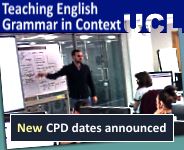Topic: Information structuring
This topic looks at how we can present the same information in different ways, by using different word orders and grammatical patterns. For instance, instead of I can understand that bit, we might change the order and say That bit I can understand to give a different emphasis. Learning about these different patterns helps in understanding the choices made by writers and speakers, and in varying the patterns used in our own writing for effect.
- « first
- ‹ previous
- 1
- 2
- 3

